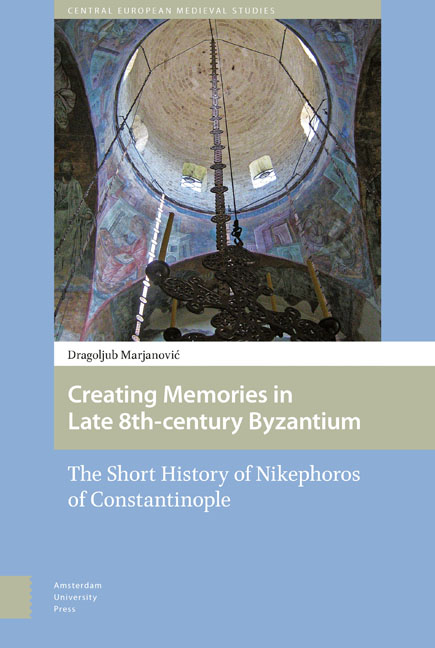Book contents
- Frontmatter
- Contents
- List of Tables
- Preface
- Introduction
- 1 Nikephoros the Layman
- 2 The Short History in the Byzantine Historiographical Tradition
- 3 Herakleios: Model of an Emperor
- 4 The Dark Century
- 5 Iconoclasts Restoring Order
- Conclusion: In Search of an Ideal Image of an Emperor
- Glossary
- Abbreviations
- Bibliography
- Index
- Frontmatter
- Contents
- List of Tables
- Preface
- Introduction
- 1 Nikephoros the Layman
- 2 The Short History in the Byzantine Historiographical Tradition
- 3 Herakleios: Model of an Emperor
- 4 The Dark Century
- 5 Iconoclasts Restoring Order
- Conclusion: In Search of an Ideal Image of an Emperor
- Glossary
- Abbreviations
- Bibliography
- Index
Summary
Due to the influence and historical role of Patriarch Nikephoros of Constantinople at the turn of Byzantium's eighth and ninth centuries, his literary heritage has attracted the attention of modern researchers dealing with various aspects of Byzantine civilization. According to the words of the author of the first monograph dedicated to the epoch and work of Patriarch Nikephoros, the fate of Nikephoros's secular work – the Short History and Short Chronicle –was somewhat unfavourable, especially when compared to his more numerous theological writings, which gained much wider circulation and use already in the Middle Ages. Likewise, the Short Chronicle enjoyed popularity among the Slavic circles familiar with the Byzantine cultural environment and its impact, while the Short History, with its two manuscript copies, remained relatively obscure even in the centuries close to the time of its author.
The first explicit reference from the Byzantine era, a sort of review of Nikephoros's Short History, occurred only in the second half of the ninth century. It came from the pen of one of the most prominent successors to Nikephoros's patriarchal see: the great Patriarch Photios, who, moreover, presented himself as Nikephoros's relative in the letter addressed to the Roman Pope Nicholas I. Photios's laudatory review of the literary features and qualities of Nikephoros's Short History, as displayed in his Bibliotheca, resulted from his tendency to connect himself to his predecessor, the Patriarch Nikephoros, both spiritually and in terms of kinship. Still, Photios's account, in which he praised Nikephoros's literary qualities as displayed in his Short History, provides valuable testimony concerning the reception and comprehension of the work in the centuries of Byzantine history that followed Nikephoros's demise in 828. In contrast to Photios's open attitude and his reflections on the nature and character of the Short History, Nikephoros's historical work appears to have enjoyed a certain degree of attention from the Byzantine historians of a later period such as George the Monk and Symeon Logothete. Could it be that the high appraisal of the Short History by Photios presented some impetus for a wider utilization of Nikephoros's work among the aforementioned Byzantine historians?
- Type
- Chapter
- Information
- Creating Memories in Late 8th-century ByzantiumThe Short History of Nikephoros of Constantinople, pp. 9 - 18Publisher: Amsterdam University PressPrint publication year: 2017



